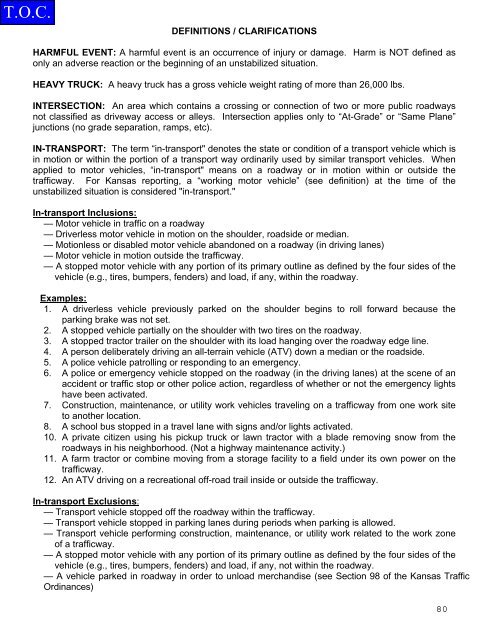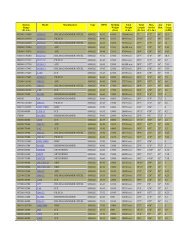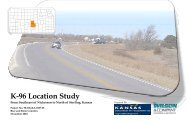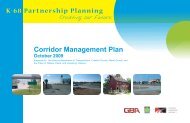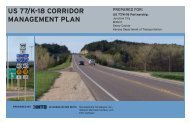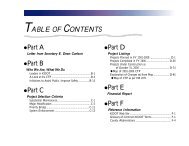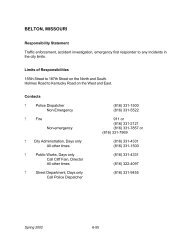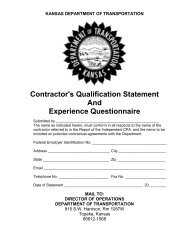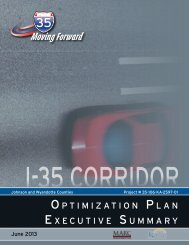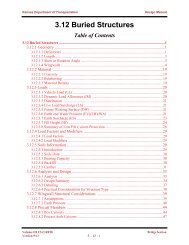KANSAS MOTOR VEHICLE ACCIDENT REPORT CODING MANUAL
KANSAS MOTOR VEHICLE ACCIDENT REPORT CODING MANUAL
KANSAS MOTOR VEHICLE ACCIDENT REPORT CODING MANUAL
You also want an ePaper? Increase the reach of your titles
YUMPU automatically turns print PDFs into web optimized ePapers that Google loves.
DEFINITIONS / CLARIFICATIONS<br />
HARMFUL EVENT: A harmful event is an occurrence of injury or damage. Harm is NOT defined as<br />
only an adverse reaction or the beginning of an unstabilized situation.<br />
HEAVY TRUCK: A heavy truck has a gross vehicle weight rating of more than 26,000 lbs.<br />
INTERSECTION: An area which contains a crossing or connection of two or more public roadways<br />
not classified as driveway access or alleys. Intersection applies only to “At-Grade” or “Same Plane”<br />
junctions (no grade separation, ramps, etc).<br />
IN-TRANSPORT: The term “in-transport" denotes the state or condition of a transport vehicle which is<br />
in motion or within the portion of a transport way ordinarily used by similar transport vehicles. When<br />
applied to motor vehicles, “in-transport" means on a roadway or in motion within or outside the<br />
trafficway. For Kansas reporting, a “working motor vehicle” (see definition) at the time of the<br />
unstabilized situation is considered "in-transport."<br />
In-transport Inclusions:<br />
— Motor vehicle in traffic on a roadway<br />
— Driverless motor vehicle in motion on the shoulder, roadside or median.<br />
— Motionless or disabled motor vehicle abandoned on a roadway (in driving lanes)<br />
— Motor vehicle in motion outside the trafficway.<br />
— A stopped motor vehicle with any portion of its primary outline as defined by the four sides of the<br />
vehicle (e.g., tires, bumpers, fenders) and load, if any, within the roadway.<br />
Examples:<br />
1. A driverless vehicle previously parked on the shoulder begins to roll forward because the<br />
parking brake was not set.<br />
2. A stopped vehicle partially on the shoulder with two tires on the roadway.<br />
3. A stopped tractor trailer on the shoulder with its load hanging over the roadway edge line.<br />
4. A person deliberately driving an all-terrain vehicle (ATV) down a median or the roadside.<br />
5. A police vehicle patrolling or responding to an emergency.<br />
6. A police or emergency vehicle stopped on the roadway (in the driving lanes) at the scene of an<br />
accident or traffic stop or other police action, regardless of whether or not the emergency lights<br />
have been activated.<br />
7. Construction, maintenance, or utility work vehicles traveling on a trafficway from one work site<br />
to another location.<br />
8. A school bus stopped in a travel lane with signs and/or lights activated.<br />
10. A private citizen using his pickup truck or lawn tractor with a blade removing snow from the<br />
roadways in his neighborhood. (Not a highway maintenance activity.)<br />
11. A farm tractor or combine moving from a storage facility to a field under its own power on the<br />
trafficway.<br />
12. An ATV driving on a recreational off-road trail inside or outside the trafficway.<br />
In-transport Exclusions:<br />
— Transport vehicle stopped off the roadway within the trafficway.<br />
— Transport vehicle stopped in parking lanes during periods when parking is allowed.<br />
— Transport vehicle performing construction, maintenance, or utility work related to the work zone<br />
of a trafficway.<br />
— A stopped motor vehicle with any portion of its primary outline as defined by the four sides of the<br />
vehicle (e.g., tires, bumpers, fenders) and load, if any, not within the roadway.<br />
— A vehicle parked in roadway in order to unload merchandise (see Section 98 of the Kansas Traffic<br />
Ordinances)<br />
80


